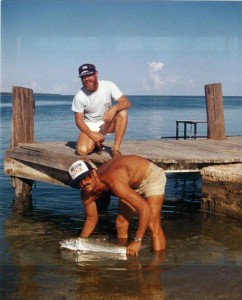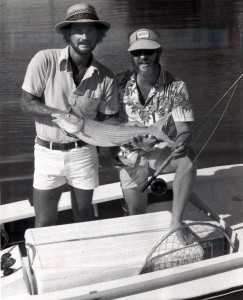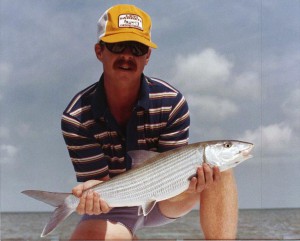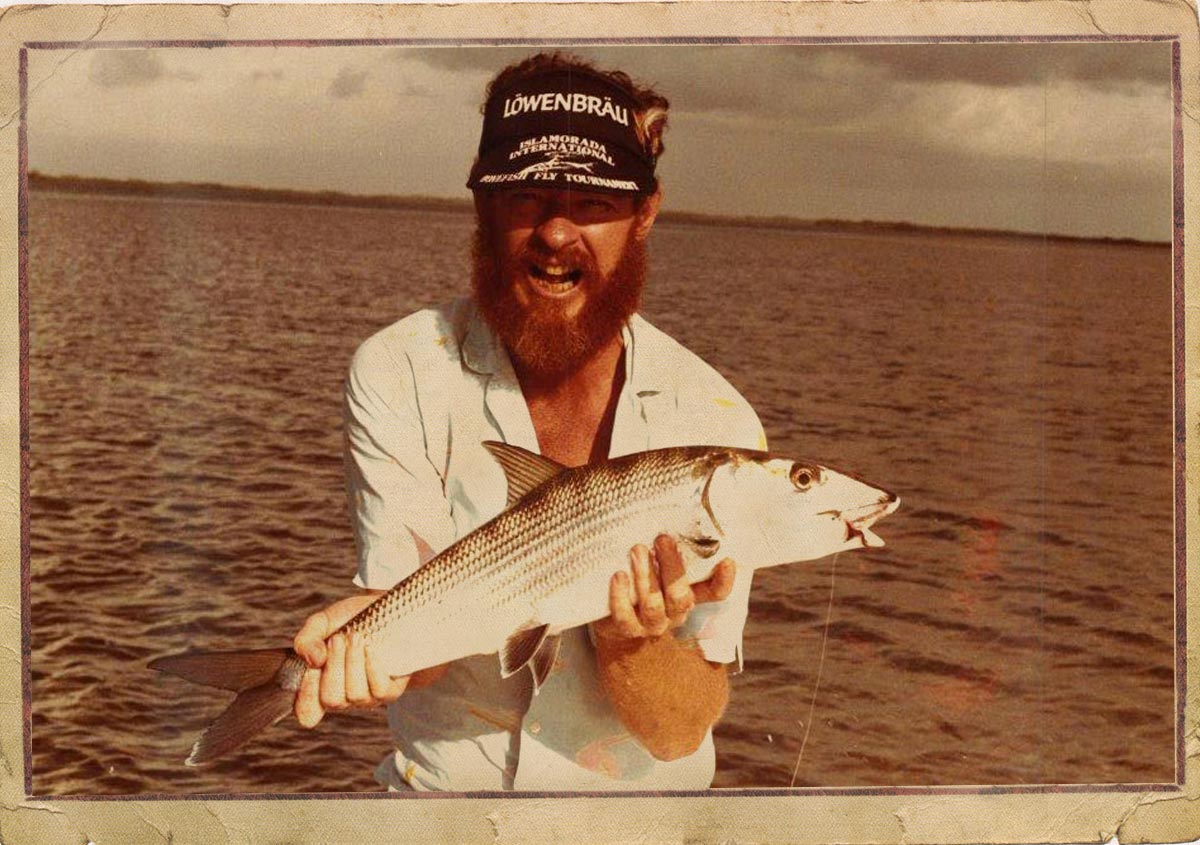By Sandy Moret
The flats of Islamorada and Florida Bay once boasted some of the finest bonefishing on our watery planet.
Due to the lush seagrass that held tons of delicious bonefish cuisine like shrimp, crabs and toadfish galore. Toadfish were a major part of the bonefish’s diet and were one of the main reasons there were such monster bones in the backcountry.
Back in the late ‘70s, I had just begun fishing the Islamorada Invitational Bonefish Fly Tournament with Captain Al Polofsky. Small bonefish did not really count for scoring, and if you brought one of those “peanuts”—at the time, a bonefish under eight pounds—to weigh-in, you were actually penalized. We knew how much all the fish weighed because they were unceremoniously brought to the dock, mostly dead, and weighed at what is now the Lorelei (known as the Islamorada Yacht Basin back then). Most anglers didn’t think much of killing fish at that time, which is why so many old photos show fish strung up at the dock.
We were total rookies fishing that tournament, but Al decided to propose a new rule at the anglers meeting that a 100-point bonus be offered for releasing bonefish alive. The rule was passed unanimously, and catch-and-release bonefishing was born in the Keys.
 That year in the tournament, Al was poling me on a bank in Everglades National Park and three monster bonefish were digging it up in very shallow water. As we came into position, I threw a number four Chico Fernandez Snapping Shrimp, and the fish all pounced on it, and one came up with the fly. We knew it was a porker from the first blistering run. We landed it and raced six miles to weigh it. The fish weighed a hefty 12.3 pounds, and we successfully released it.
That year in the tournament, Al was poling me on a bank in Everglades National Park and three monster bonefish were digging it up in very shallow water. As we came into position, I threw a number four Chico Fernandez Snapping Shrimp, and the fish all pounced on it, and one came up with the fly. We knew it was a porker from the first blistering run. We landed it and raced six miles to weigh it. The fish weighed a hefty 12.3 pounds, and we successfully released it.
We had lost an hour of fishing time running to the weigh-in, but we still had a good tide, so back we headed to that same spot. Well, there were now two fish tailing in the exact same spot where we had just caught the first big one. I threw the snapping shrimp again, and again hooked up. Another sizzling run, and we landed the fish and headed off to weigh-in. This fish weighed a whopping 12.4 pounds. As we released the second fish, I couldn’t believe my luck, catching not one but two over 12-pound bones in the exact same spot in a tournament.
I started fishing South Florida when I moved down from Georgia to start a business in the early ‘70s. At the time, flats fishing was still relatively new, but I quickly befriended some of the pioneers of the sport like Flip Pallot, Steve Huff and Chico Fernandez, all of whom showed me the amazing fishing south Florida had to offer. It was truly incredible, which is why it’s been so hard for me to watch what’s happened over time to the fishery and habitat I grew to love over the past nearly 50 years.
There’s a phenomenon called “shifting baseline syndrome” in which standards are lowered over time as a result of successive generations lack of knowledge of the historical and more natural conditions of something.
 Fisheries scientist Daniel Pauly first wrote about it in a 1995 paper, and gave a TED talk on the topic in 2010. He cites an example of his work in Sakumo Lagoon in Ghana in the ‘70s, where a species of tilapia served as an important food source for the locals. He returned 27 years later to find that the average fish was half the size that they had been in the ‘70s, but the fishermen were unaware of the decline and were happy with the fishery. He observed that, “nothing had changed, but everything had changed.”
Fisheries scientist Daniel Pauly first wrote about it in a 1995 paper, and gave a TED talk on the topic in 2010. He cites an example of his work in Sakumo Lagoon in Ghana in the ‘70s, where a species of tilapia served as an important food source for the locals. He returned 27 years later to find that the average fish was half the size that they had been in the ‘70s, but the fishermen were unaware of the decline and were happy with the fishery. He observed that, “nothing had changed, but everything had changed.”
The story of Florida Bay and the Everglades is no different, though even those who have been fishing it for just a few years have noticed declines in habitat, fish numbers and fish size, indicating how grave of a problem we are truly facing. For those of us who have been fishing there for almost half a century or even longer, the declines feel absolutely devastating.
Wherever your historical baseline falls, whether a “peanut” bonefish is eight pounds or two, it’s clear that there is a serious problem. If you haven’t seen it firsthand, trust me as someone who has been observing the fishery for many decades, and trust the many others who are saying the same thing.
Nature is resilient; past recoveries have shown us that.
When feather-adorned hats were popularized in the early 20th century, wading birds were hunted to the brink of extinction in the Everglades, but the populations recovered dramatically when plume hunting was later outlawed. When redfish were being commercially fished on a mass-scale in Florida during the blackened redfish craze of the ‘80s, the commercial redfish ban several years later resulted in a substantial recovery of the population.
 The challenges facing the Everglades and Florida Bay are more complex, but the logical steps to address them have been outlined, they are just being implemented too slowly. One important and urgent step is creating reservoirs south of Lake Okeechobee to properly store, clean and convey fresh water, with less water being sent east and west to devastate the estuaries and more water heading south to hydrate Florida Bay, better mimicking historical freshwater flows. Efforts to accomplish this are underway, but still face significant opposition from the sugar industry and some politicians. Awareness of the issues and history of the region has led to more people, organizations and companies joining in this life or death fight for the Everglades through the Now or Neverglades movement, an effort I’ve been a part of since its inception. I can only hope that our efforts pay off, and that someday again a “peanut” bonefish in Florida Bay is one that weighs nearly eight pounds.
The challenges facing the Everglades and Florida Bay are more complex, but the logical steps to address them have been outlined, they are just being implemented too slowly. One important and urgent step is creating reservoirs south of Lake Okeechobee to properly store, clean and convey fresh water, with less water being sent east and west to devastate the estuaries and more water heading south to hydrate Florida Bay, better mimicking historical freshwater flows. Efforts to accomplish this are underway, but still face significant opposition from the sugar industry and some politicians. Awareness of the issues and history of the region has led to more people, organizations and companies joining in this life or death fight for the Everglades through the Now or Neverglades movement, an effort I’ve been a part of since its inception. I can only hope that our efforts pay off, and that someday again a “peanut” bonefish in Florida Bay is one that weighs nearly eight pounds.
Please support the Now or Neverglades movement by adding your name alongside 56,000+ who have signed the Now or Neverglades Declaration.
Join the coalition for Now or Neverglades Sportfishing Day on April 11th in Tallahassee.
Sandy Moret Gink & Gasoline www.ginkandgasoline.com hookups@ginkandgasoline.com Sign Up For Our Weekly Newsletter!


Thanks for your article.
Sandy is an icon and he has taken up a cause that is critical not only to bonefish, tarpon, and other gamefish species but the quality of life in South Florida. I have friends with a place on Sanibel island who recognize the devastating creep of dead water and sea grass across their bay waters. While they are not fishermen, they would wholeheartedly support measures to halt the decline of an ecosystem that impacts them now but will change a place they love in ways that will mean their grandkids will never experience the quality and beauty of a special place. This is not just a fishing issue or economic issue. It is a quality of life issue. Kudos to Sandy and those who join him in this fight.
Just came back from there, and the alarms were being rung everywhere. At least in places we visited. That is good news. Didn’t see many a billboard in south Florida, but signage along highway 1 certainly wouldn’t hurt the causal observer.
I was talking to Sandy a few years ago at his Islamorada Fly Shop about the very same thing. For over 30 years I enforced water quality Regs in Md, and saw a storm named Agnes completely devastate the largest estuarine eco system in the Country, Chesapeake Bay, after years of runoff issues, many miles of dead zones were the result, (no dissolved oxygen). In SW Florida, I’ve seen the Peace River listed on the most dangered Rivers in the Country, which feeds into Charlotte Harbor. I’ve gave classes on water quality issues in the Harbor and other places to one of the largest fishing groups like the PGI fishing club. For the most part they were not concerned about water quality issues, and that’s sad. As I told Sandy one of the biggest problems here in Florida are dedicated groups to take on the State regarding oversight regulations. In Md, there was the Chesapeake Bay Foundation who had the money and power to fight both the State and Federal Gov’t, and make real changes. There really isn’t anything like that in Fl. There are the people including fishermen. So unless the people get involved, these fragile eco systems could go the way of Maryland. One thing I’ve learned after decades of water quality work is once the eco system is destroyed, the amount of money needed to fix it, is far beyond what the tax payers are willing to spend to right the ship.
My guess is this is going to eventually, if it hasn’t already, effect property values. And it is with heavy heart that i believe this might be the only thing that wakes up the officials that supposedly “represent” the people. I am embarrassed to call myself a human being if this is what it takes…
I fish around Charlotte Harbor which is also affected. I have been looking for a way to help this cause, which I feel I just did by signing up. Hopefully I can do more in the future. Thanks for an especially good post today.
In these times, it is more important than ever to support organizations like “Now or Neverglades”.
Please add your name to the list, and spread the word…
Our Florida waters are loosing the battle. Florida keeps voting for money hungry as* holes that only want to line their pockets. Thanks for your support! Our fishing is rapidly going down hill because of these Lake Okeechobee water releases. At the same time, the Everglades is dying for the water.
Mother nature needs to be left alone. The Caloochatchee river man decided to change messed up a lot and if I recollect, it had to be put back the way it was. Every time man gets involved changing God’s work, it’s a screwup.
Pingback: July News – Now Or Neveglades